The Best Content Management Systems
Content Management systems (CMS) are essential for modern businesses looking to maintain and scale their digital presence efficiently. These systems enable users to create, manage, and modify website content without needing specialized technical knowledge. Let's start with the most popular CMS on the internet, WordPress.
WordPress

WordPress is a powerful and versatile open-source content management system that allows users to create and manage a wide range of websites with ease. Initially developed as a blogging platform, WordPress has evolved into a full-fledged CMS capable of handling complex websites, e-commerce stores, and community platforms. Its user-friendly interface and extensive customization options make it the top choice for users worldwide. With WordPress, you can design your website using thousands of themes and enhance its functionality with over 50,000 plugins available, ensuring your site can grow and adapt to your needs.
One of the key advantages of WordPress is its intuitive block-based editor, introduced in version 5.0, which simplifies the process of creating and arranging content. This CMS also supports extensive SEO features, ensuring your website is optimized for search engines right out of the box. Moreover, WordPress's large community of developers and users continuously contributes to its growth, providing a wealth of resources, tutorials, and support.
Note that hosting WordPress websites requires careful consideration, as your website's performance heavily depends on the hosting provider. Premium hosting providers can ensure blazing-fast WordPress deployments. One of the best premium web hosting providers is Kinsta*
Enhancing WordPress with Advanced Page Builders
WordPress, while incredibly powerful on its own, becomes even more versatile with the addition of advanced page builders. These tools provide drag-and-drop functionality, pre-built templates, and extensive customization options, enabling users to design unique, professional websites without coding expertise. By combining WordPress’s robust content management capabilities with the creative freedom of page builders, users can craft tailored websites that cater to both functional and aesthetic needs, making the platform adaptable for projects of any scale or complexity.
Elementor
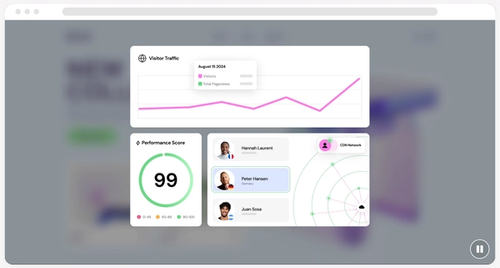
Elementor is a powerful website builder platform designed for WordPress, offering an intuitive, visual-first approach to web design. It provides a wide array of tools and features that allow users to create professional, pixel-perfect websites without any coding knowledge. With Elementor, you can design, edit, and update your website in real-time, making it an ideal choice for designers, developers, and marketers who seek creative freedom and efficiency. The platform supports dynamic content integration, reusable templates, and SEO optimization, ensuring that your website not only looks great but also performs well.
Elementor also includes advanced features such as the Loop Builder, Posts Widget, and Taxonomy Filter, which enhance the functionality and customization of your website. The platform's integration with AI capabilities further streamlines the design process, allowing users to generate text, code, and images instantly. Additionally, Elementor Hosting provides a secure and high-performance environment tailored for Elementor-built websites, ensuring fast loading times and robust security measures. With a global community and extensive support resources, Elementor continues to empower web professionals to create stunning, high-performing websites effortlessly.
Divi
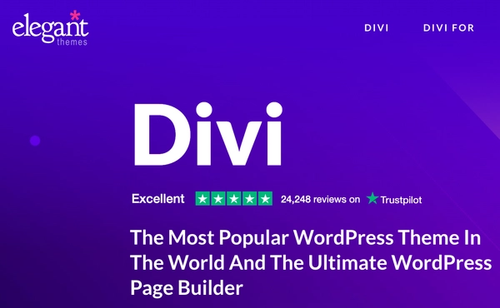
Divi, developed by Elegant Themes, is more than just a WordPress theme; it is a comprehensive website building platform that replaces the standard WordPress editor with a vastly superior visual editor. Divi empowers users to create stunning website designs without any coding knowledge. Its intuitive drag-and-drop interface makes it easy to add, delete, and move elements around on the front end of your website. This real-time editing experience allows you to see the results instantly, providing full design control over your site’s appearance and functionality.
One of Divi’s standout features is its extensive customization options. Users can choose from over 2,000 pre-made website layouts, and new designs are added weekly. Divi also supports a wide range of design elements, including animations, background effects, and advanced hover options, enabling you to create interactive and visually appealing websites. Additionally, Divi's responsive design capabilities ensure your site looks great on all devices. With Divi, you can streamline your workflow, improve team collaboration, and build professional websites faster and more efficiently.
Marketers' Favorite Content Management Systems
Marketers favor certain content management systems for their blend of functionality and ease of use. These platforms feature intuitive interfaces that simplify content management, even for those with limited tech skills. Notably, their integration with digital marketing tools facilitates seamless multi-channel campaign management. Features like pre-built templates and drag-and-drop editors also expedite campaign launches and updates, significantly boosting marketing efficiency. Let's take a closer look at the tools that embody these benefits and explore why marketers highly value them.
Hubspot CMS*

HubSpot CMS is a highly integrated platform that combines website creation capabilities with marketing, sales, and customer service functionalities. Built on an AI-powered system, it is designed to streamline and enhance the digital presence of businesses. HubSpot CMS supports a diverse array of AI tools that assist in content generation, campaign automation, and converting visitors into leads, making it a potent tool for inbound marketing strategies.
The CMS offers robust content management features that allow users to create, manage, and personalize content effortlessly across multiple channels. This is coupled with powerful analytics to track the effectiveness of content and strategies in real time. For businesses looking to scale, HubSpot provides advanced security features, seamless app integrations, and performance metrics that help in making informed decisions quickly and efficiently.
Overall, HubSpot CMS stands out for its comprehensive suite of tools that support all phases of digital marketing and content management. Its ability to integrate deeply with other HubSpot products enhances its utility, making it a versatile choice for businesses aiming to optimize their online engagements and convert leads into satisfied customers.
Adobe Experience Manager
Adobe Experience Manager (AEM) stands out as a comprehensive Content Management System (CMS) tailored for businesses aiming to establish a robust digital presence. AEM offers a unique blend of content management capabilities, enabling the creation, management, and optimization of digital assets across various platforms. Its modular and dynamic architecture allows for high customization, setting it apart from traditional, monolithic CMS platforms. This flexibility is vital for tailoring content and publishing strategies to meet specific business needs, enhancing the digital marketing effectiveness.
AEM's advanced security protocols ensure superior data protection and digital asset security compared to other CMS options. Its integration within the Adobe family, including Adobe Cloud, Adobe Target, and Adobe Analytics, offers powerful tools for digital marketing, analytics, and personalization. The built-in Digital Asset Management (DAM) system streamlines content distribution, making AEM an efficient choice for managing a comprehensive digital presence. Its SEO optimization tools further ensure that content reaches the intended audience effectively, improving visibility and engagement. For businesses looking for a scalable, customizable, and secure CMS with robust integration capabilities, AEM presents a compelling option.
Best Content Management Systems with Drag and Drop Website Builders
Now, let's explore the leading content management systems featuring drag-and-drop website builders and discover why they are favored by a vast user base.
Wix
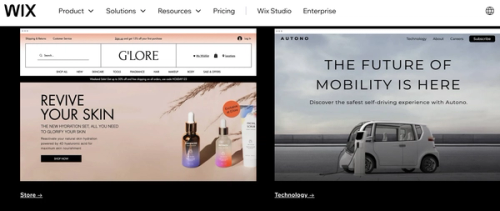
Wix is a comprehensive content management system (CMS) that offers a complete solution for building and managing websites. It provides a robust infrastructure, business features, advanced SEO, and marketing tools without requiring any programming knowledge. The platform's intuitive drag-and-drop interface and pre-made template designs make it easy for users to customize their websites. With Wix, users can create and update their websites effortlessly, ensuring that their content is always fresh and relevant. Additionally, Wix offers various app extensions to enhance the functionality and performance of websites.
One of the key benefits of Wix is its ability to integrate dynamic content without coding. Users can connect their CMS collections to Dynamic Pages and Repeater elements, streamlining the process of managing recurring content and layouts. This integration allows for automatic updates to site elements, improving efficiency and consistency. Wix also supports SEO-friendly features, such as clean URL structures and meta tags, which help improve search engine rankings. The platform caters to a wide range of users, from small business owners to large enterprises, providing an accessible and powerful solution for website creation and management.
Squarespace

Squarespace is an all-in-one content management system (CMS) designed to help users build and manage beautiful websites with ease. Offering professionally designed templates and a user-friendly interface, Squarespace enables anyone to create stunning websites, whether for business, personal use, or creative projects. The platform includes built-in support for SEO best practices, ensuring your site can attract and retain visitors. Additionally, Squarespace provides a variety of tools for customizing your site's design and functionality, making it a versatile solution for users with different needs and skill levels.
Squarespace Commerce is a comprehensive set of features for selling products and services online. By connecting a payment processor, users can process transactions, issue refunds, and manage inventory. The platform supports both online and in-person sales through the Squarespace app and compatible Square reader. Other notable features include integrated email marketing, domain registration, and scheduling tools, which are all designed to enhance user experience and streamline business operations.
Webflow
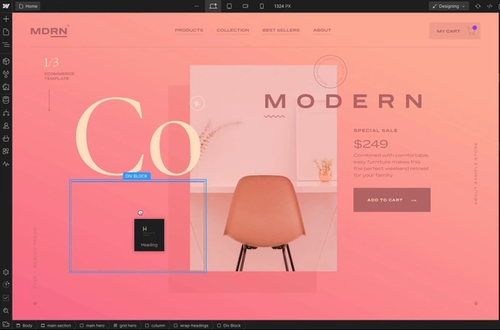
Webflow's visual-first and composable CMS empowers teams to create on-brand website experiences efficiently. This platform allows users to write, edit, and publish content directly within Webflow without the need for developer assistance. Marketing teams can benefit from the ease of creating, editing, and publishing CMS content and Collections swiftly, thanks to Webflow's user-friendly interface that renders changes in real-time. The ability to preview content before going live, manage SEO elements directly, and create reusable templates for dynamic content makes Webflow a powerful tool for content management.
Webflow also excels in providing a seamless collaborative environment. Its CMS supports multiple workspaces with specific permissions, allowing different user roles such as editors, authors, and administrators to work together without disrupting each other's contributions. The platform's robust integration capabilities through its App Marketplace and powerful headless CMS APIs enable teams to connect Webflow with their existing tech stack effortlessly. With features like custom automated workflows, visual design tools, and global hosting, Webflow ensures high performance and scalability for enterprises, making it an essential tool for modern content management.
Ghost

Ghost is a powerful open-source content management system designed for professional publishers, bloggers, and businesses. It provides a modern platform to create, share, and grow a business around content, offering tools for building websites, publishing content, sending newsletters, and managing paid subscriptions. With Ghost, you have complete control over your website's design and branding, supported by a vast marketplace of custom themes and templates. The intuitive editor and advanced workflows ensure a seamless publishing experience, allowing users to expand their stories with various multimedia elements and deliver posts by email newsletters.
Ghost simplifies the process of building an indie publication with memberships and subscriptions. Native signup forms turn anonymous views into logged-in members, enabling free or paid subscriptions to support your work. The platform offers detailed engagement analytics, helping you understand your audience and tailor your content strategy. Ghost's integration capabilities with numerous third-party apps and services enhance its functionality, making it a versatile solution for creators, publishers, and businesses. Managed by the nonprofit Ghost Foundation, the platform remains independent and user-funded, ensuring continuous development and support.
By the way, this blog uses a modified version of one of the Ghost themes.
Dorik Cms
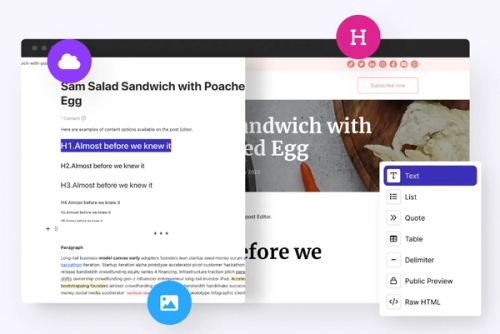
Dorik CMS is a modern content management system designed to simplify website building and management while delivering powerful features. Dorik ensures your website is engaging, professional, and optimized for search engines. Its user-friendly interface allows users to design and customize every detail of their websites—layouts, designs, and content—without requiring any coding expertise or compromising on quality.
What sets Dorik apart is its affordability compared to platforms like Webflow, Squarespace, and Wix. Unlike these competitors, Dorik offers a lifetime plan, making it an attractive one-time investment for small businesses, freelancers, and agencies. The platform also excels in flexibility, supporting features like membership site creation with free or paid tiers, Stripe payment integration, and audience-specific content controls. Team collaboration tools and seamless integrations with popular apps like Airtable, Zapier, and Mailchimp further enhance its versatility, making Dorik a standout choice for modern, cost-effective web development.
Headless CMS: Top Headless Content Management Systems
Magnolia
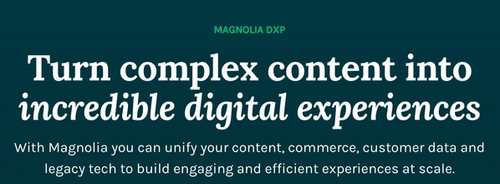
Magnolia is a powerful content management system (CMS) that excels in managing and delivering digital experiences across multiple channels. It integrates seamlessly with various third-party systems, such as e-commerce platforms, CRM systems, and DAM solutions, enabling a unified digital presence. Magnolia's strength lies in its headless CMS architecture, which separates content management from the presentation layer, allowing for flexible content delivery to websites, mobile apps, social media, and more. This separation ensures that content can be centrally managed and efficiently distributed across various digital touchpoints.
With a focus on scalability and integration, Magnolia supports complex digital strategies for large enterprises. Its features include robust targeting and personalization capabilities, making it easy to tailor content to different user segments. Magnolia also offers extensive support for multilingual and multisite environments, as demonstrated by its successful implementations for clients like Rittal and Baloise. The platform's flexibility is enhanced by its open suite approach, which allows businesses to adapt quickly to changing market conditions and integrate new technologies effortlessly. Magnolia's comprehensive support and intuitive user interface further streamline content management, making it a powerful tool for creating engaging digital experiences.
Sanity
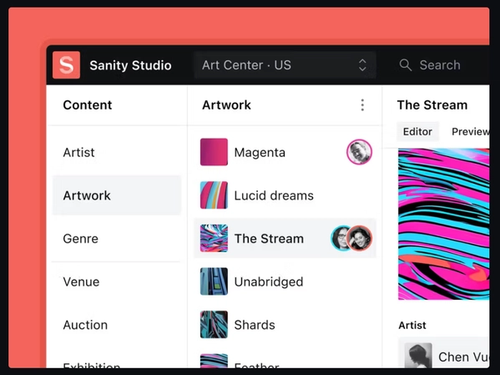
Sanity is a dynamic and versatile content management tool that offers a fully decoupled backend, allowing for total composability and flexibility. It provides a unique content editing environment where users can connect to anything and treat content as data with GROQ, a powerful query language. Sanity's platform supports a richer writing experience with intuitive interfaces, enabling real-time collaboration and advanced publishing workflows. The built-in AI assistant and seamless integration with best-in-breed technologies ensure innovative and automated content management across multiple touchpoints.
Sanity's Composable Content Cloud is designed to centralize content creation, ensuring coherent messaging and efficient content reuse. Its robust API framework supports syncing content between various sources, making it a perfect fit for scaling multi-brand e-commerce and omnichannel media distribution. With a focus on delivering remarkable digital shopping experiences and driving customer engagement, Sanity empowers businesses to innovate and automate their content workflows. The platform's ability to provide a single source of truth for global markets positions it as a leader in the headless CMS landscape, offering scalable solutions for enterprises worldwide.
Contentful
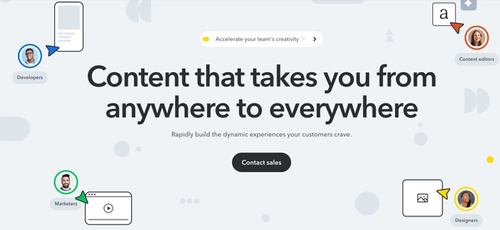
Contentful is a German-made content management system for clients with deep pockets, designed to streamline the process of managing and delivering content across various platforms. As a headless CMS, Contentful separates content creation from content presentation, allowing developers and content creators to work more efficiently. The platform offers a robust API that ensures secure access and management of content through access tokens and HTTPS. With features like a What You See Is What You Get (WYSIWYG) editor, support for multiple environments, and a detailed version control system, Contentful provides a flexible and scalable solution for businesses looking to enhance their content strategy.
One of Contentful's standout features is its ability to create and manage multiple environments, making it ideal for development, staging, and production workflows. This ensures that content changes can be tested and reviewed before going live. Additionally, the platform supports webhooks for real-time updates and automated workflows, enhancing the efficiency of content operations. Contentful's API-first approach and comprehensive content modeling capabilities allow businesses to create structured content that can be easily reused and integrated with other systems, making it a versatile tool for modern content management needs.
Wagtail
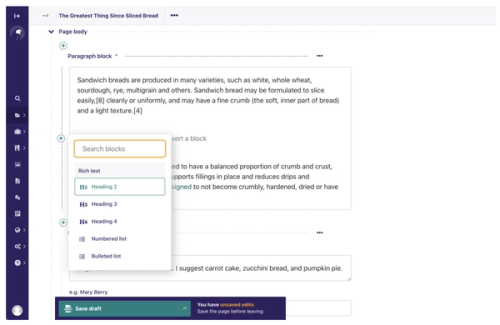
Wagtail is a highly intuitive, powerful, and flexible open-source content management system (CMS) built on the Python-based Django framework. It is designed to cater to the needs of both developers and content editors, offering an easy-to-use interface that allows for the management of websites without requiring in-depth technical knowledge. Wagtail's user-friendly StreamField interface provides editors with creative control over content, enabling the addition of new content options with minimal coding effort.
Wagtail stands out for its flexibility, allowing for the creation of highly customized websites with complex layouts and features tailored to the requirements of content editors. It supports a wide range of plugins, themes, and components, enhancing its extensibility and ability to adapt to various web project needs. Security is a priority, with Wagtail incorporating Django's robust security features to safeguard against common vulnerabilities. Additionally, Wagtail's scalability, thanks to its Django foundation, makes it suitable for high-traffic websites, ensuring smooth performance regardless of the volume of content or number of users.
Moreover, Wagtail includes enterprise-level features such as user and group permissions, content moderation workflows, and content editing history tracking, catering to the needs of large teams. Its maturity, derived from years of development and real-world application, reflects a balanced approach that empowers both developers and content editors. The CMS's philosophy, the Zen of Wagtail, emphasizes simplicity and efficiency, avoiding overwhelming users with unnecessary complexity. Organizations worldwide, including Google, NASA, and the British NHS, trust Wagtail for their digital projects, leveraging its capabilities to create secure, accessible, and highly customizable websites.
Strapi
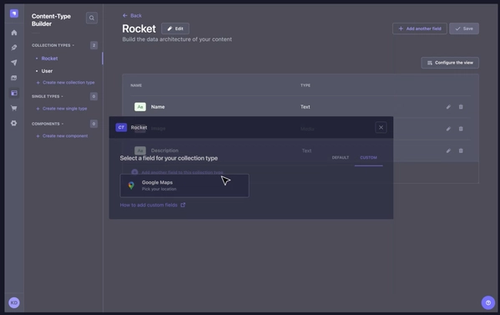
Strapi is a leading open-source headless CMS that offers developers the flexibility to use their favorite tools and frameworks while allowing editors to manage content seamlessly. Written in JavaScript for the Node.js runtime environment, Strapi provides functions typical of a CMS, such as a text editor, user management, and a media library. Additionally, it serves as a web framework for web services, enabling the development of custom functions and API endpoints. Strapi supports multiple databases, including SQLite, MySQL, and MariaDB, with data models created via configuration files or a visual editor.
One of the core strengths of Strapi is its ability to generate APIs automatically from configured data models, offering endpoints for reading, creating, editing, and deleting entries. The API supports data filtering and pagination, and with a GraphQL plugin, it allows efficient querying of complex data relationships. Strapi also features a user-friendly admin interface for creating and managing content, making it accessible to non-technical users. Popular among developers, Strapi powers websites and applications for renowned organizations like IBM, Walmart, and NASA, offering a robust, scalable solution for content management across various platforms and devices.
Prismic
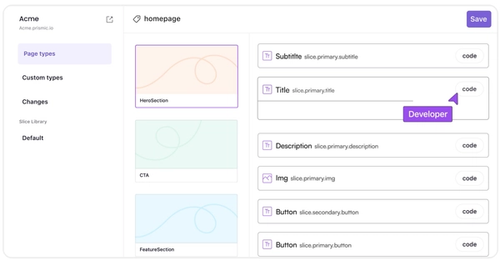
Prismic is a headless content management system (CMS) that integrates seamlessly with modern development frameworks like Next.js, Nuxt, and SvelteKit. It empowers marketers and developers by providing a flexible, API-driven approach to content management that supports fast-paced, on-brand page releases. The platform features a custom Page Builder where marketers can use pre-built components to quickly assemble and update web pages, while developers have the freedom to continuously enhance the component library.
The core functionality of Prismic revolves around its use of "Slices" — reusable custom content blocks that can be assembled into web pages. This modular system allows for dynamic page construction and easy content updates, which is ideal for managing brand consistency across various channels. Additionally, Prismic’s Slice Machine facilitates local development, enabling developers to create and ship components that marketers can then utilize within a visual interface to build engaging and visually appealing pages.
Prismic stands out for its ease of use, collaborative features, and robust API, making it a powerful tool for digital teams looking to streamline their content workflows. With features like content versioning, scheduled publishing, and multi-lingual support, Prismic ensures that content delivery is both efficient and effective, meeting the needs of businesses in a digital-first world.
Hygraph
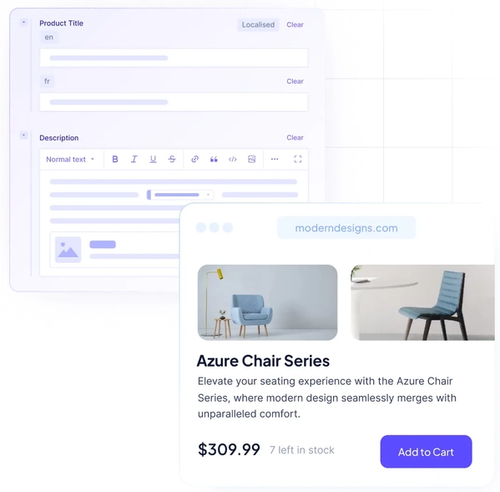
Hygraph is a headless CMS designed to streamline and unify digital content management across multiple platforms using a GraphQL-native, API-first approach. It is built to support content federation, enabling businesses to manage content from multiple sources in one centralized system. This feature allows for a seamless integration of data from various back-end systems into a single GraphQL API, enhancing the ability to deliver dynamic digital products at scale.
With Hygraph, developers can build applications for any platform, increasing content velocity and improving user engagement through high-performance applications. The CMS's powerful API supports complex queries and mutations, offering developers the flexibility to create custom roles with specific permissions and manage global content needs efficiently. Additionally, Hygraph emphasizes collaborative content creation, allowing multiple editors to work simultaneously within defined workflows and custom stages from creation to publishing.
Hygraph's integration capabilities extend to various digital ecosystems, making it possible to connect with headless commerce systems, PIMs, and other tools to enrich the content lifecycle. Its marketplace features apps that enhance platform capabilities, such as automated translations and personalized content delivery, making Hygraph a robust solution for organizations aiming to optimize their content strategies in a multi-channel digital environment.
DatoCMS
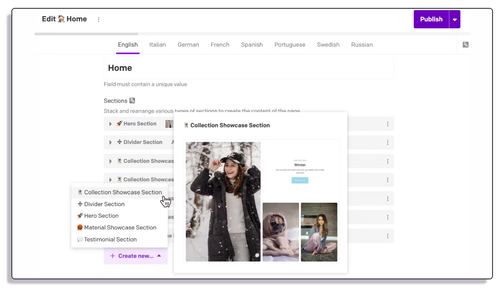
DatoCMS offers a powerful Content Management API designed to manage and structure the content of projects efficiently. This API supports a broad range of operations, such as creating, updating, deleting, and fetching content, making it a robust tool for developers. To ensure optimal performance for public-facing web and mobile projects, DatoCMS recommends using the GraphQL Content Delivery API, which is optimized for speed and delivered under CDN.
The API encompasses over 40 resources and 150 endpoints, accommodating a wide array of use cases from managing schemas to detailed content interactions. It adheres to the JSON:API specification, which guarantees a consistent and coherent interaction across various resources. For enhanced security and functionality, all API requests are made over HTTPS, and authentication is required via API tokens.
DatoCMS is renowned for its headless CMS capabilities, providing a streamlined solution for delivering content across multiple channels. This architecture facilitates rapid content updates, enabling businesses to maintain a cohesive brand message across various platforms without the inefficiencies of traditional CMS systems like WordPress. The headless approach not only centralizes content management but also supports agile methodologies and global scalability, ensuring that content is performant, secure, and accessible worldwide.
Contentstack
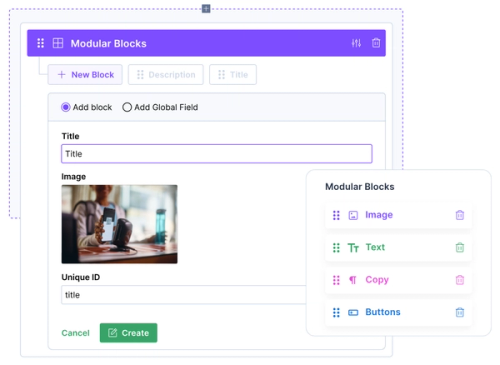
Contentstack emerges as a leading headless, API-first content management system (CMS) designed to support the complexity and speed required in modern digital experiences. It offers a robust Content Management API that allows developers to create, update, delete, and fetch content dynamically across various digital platforms. Contentstack's architecture is built to integrate seamlessly with modern development frameworks and supports omnichannel content delivery, which is essential for providing consistent user experiences across all digital touchpoints.
The platform enhances developer productivity through its Management SDKs, which interact with the Content Management APIs to streamline content operations within the CMS. Contentstack also offers advanced features like automation hubs, workflows, and live preview options that facilitate efficient content management cycles. These features allow content managers to preview changes in real-time, automate repetitive tasks, and manage content flows more effectively, ensuring content accuracy and timeliness across platforms.
Contentstack's commitment to a composable architecture allows businesses to tailor their tech stacks to their specific needs without being locked into a specific framework or technology. This flexibility, combined with its powerful API and developer tools, makes Contentstack an ideal choice for businesses looking to drive digital innovation and create seamless customer experiences in a rapidly evolving digital landscape.
Payload CMS
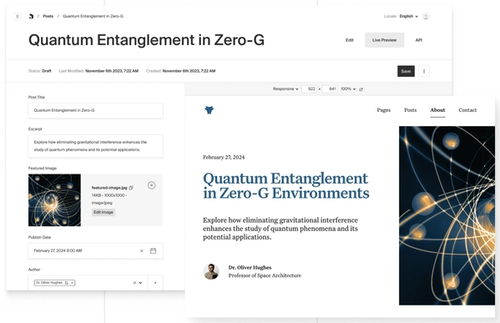
Payload CMS is a modern, open-source headless CMS designed to enhance the productivity and creativity of development teams. Built as a code-first system, Payload integrates deeply with contemporary development frameworks such as React, Vue, and Angular, allowing developers to craft rich digital experiences without the constraints of traditional CMS systems. Its focus on delivering a best-in-class editing environment, coupled with advanced field types and real-time content management capabilities, positions it as a flexible solution for managing diverse content needs.
This CMS supports dynamic fields like Arrays and Blocks, enabling developers to build complex data models that are easily manageable through its user-friendly admin UI. Payload CMS also champions strong security features, such as SAML and OAuth 2.0 integration for authentication, and function-based access control to secure data at both document and field levels. Moreover, its support for AI tools within the CMS for tasks such as translation and content generation underscores its commitment to streamlining content workflows.
By leveraging its flexible APIs and extensible admin panel, Payload CMS not only reduces development time but also enhances the scalability of business applications. It embodies a powerful platform for developers seeking to utilize a headless architecture that supports extensive customization and efficiency, making it a robust tool for enterprises aiming to optimize their digital content strategies.
Tinacms
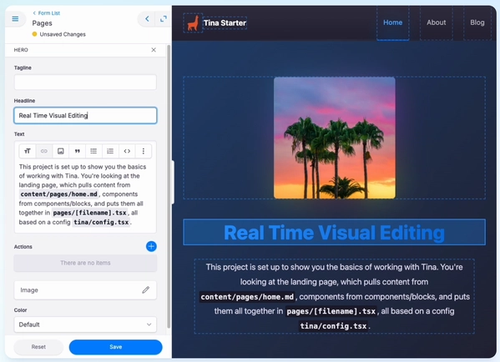
Tinacms is an innovative, fully open-source headless CMS that champions a git-based workflow, ensuring your content remains within your repository and not locked within a third-party service. It supports a variety of file types including MDX, Markdown, JSON, etc., and facilitates easy content fetching through Tina's Data Layer. This approach allows for a seamless integration with your development workflow, placing a strong emphasis on a code-first methodology that is fully typed. Tina's configuration is done directly within your repository, offering a high degree of control and customization over your CMS setup.
User feedback highlights Tina's ease of installation, its exceptional typed NextJS integration, and a live editing experience that rivals any other CMS on the market. The simplicity and intuitiveness of its admin interface make it not only developer-friendly but also accessible for content editors. Features such as click-to-edit have been praised for their ease of use and seamless integration, providing a user experience that feels almost magical. TinaCMS stands out for its in-context editing capabilities, which have been universally acclaimed by developers and content creators alike, marking it as a preferred choice for those seeking a flexible, user-centric content management system.
Prepr

Prepr is a high-performing content management tool recognized for its advanced features, including a headless, data-driven CMS that facilitates publishing across multiple platforms and delivers personalized content. This innovative approach enables the creation of rich content editing, adding video, audio, and images to enhance content pages. Additionally, Prepr offers localization features to connect with customers in every language, and multi-brand publishing to manage different websites and brands with a single solution.
Prepr excels in content integration, allowing the addition of content from external sources to content pages, and features event data management for capturing relevant data for optimization and personalization. The platform supports the creation of landing pages aimed at driving conversions, A/B testing for content optimization, and personalization to create hyper-personalized customer experiences. Furthermore, it includes recommendations to make relevant content suggestions, improving user engagement and time spent on the site.
Best Content Management Systems for Developers
When considering the best content management systems for developers, certain platforms stand out for their extensive customization capabilities and robust developer tools. These systems offer advanced features like API access, extensive plugin ecosystems, and the ability to deeply customize or extend the core functionalities, catering to the specific needs of developers who require more control and flexibility. Such platforms not only support custom development but also encourage a thriving community of developers, providing comprehensive documentation and a supportive network for troubleshooting and innovation.
Statamic
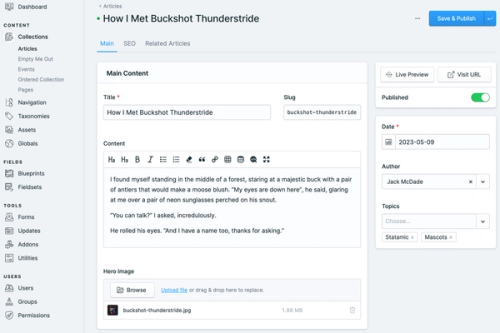
Statamic stands out in the CMS landscape with its flexible, flat-file or database approach and its seamless integration with Laravel. It caters to both developers and marketers by providing a modern, intuitive interface and a powerful content editing experience. Statamic's unique selling points include its capability to run fully stack or headless, and its adaptability to serve as a static site generator, making it a versatile choice for a wide array of web projects.
This CMS is especially notable for its version control capabilities, allowing content history viewing, draft working, and easy publishing management. The collaborative features prevent editing conflicts, making it ideal for team environments. Statamic also supports a broad range of field types and content structuring options, empowering developers to build custom solutions that are tailor-made for their specific content requirements.
Moreover, Statamic enhances development workflows with features like command-line tools to streamline tasks and direct control over content structure through coding rather than just UI manipulation. These features, combined with the ability to extend functionality via addons and integrate with modern development stacks, make Statamic a robust platform suitable for building dynamic, scalable web applications.
Modx
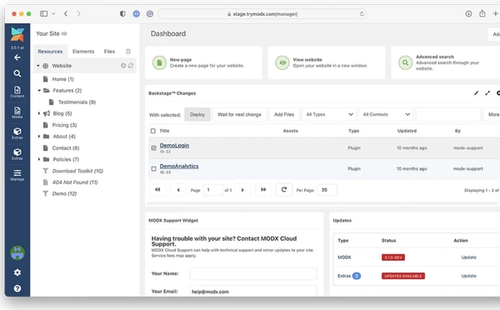
MODX stands as a formidable platform in the digital landscape, offering a blend of open-source CMS capabilities, development frameworks, and managed cloud hosting. It is engineered for those who seek creative freedom without the limitations imposed by traditional CMS platforms. MODX is celebrated for its blazing speed, robust security, and unparalleled flexibility, enabling users to create, collaborate, and deliver digital experiences with less complexity and bloat.
The platform is not just about providing a space for content creation; it's about empowering users with powerful collaboration tools and intuitive content staging capabilities. MODX Cloud further enhances this experience by offering fully-managed secure hosting, coupled with expertly tuned platforms for an optimized MODX Revolution experience. Security is a core aspect of MODX, with a proven track record as the most secure open-source CMS. This, combined with its ability to deliver fast, SEO-optimized, and lightweight websites, makes MODX a top choice for those prioritizing speed, security, and creative freedom in their digital endeavors.
Traditional Open-Source Content Management Systems
Traditional open-source content management systems remain highly valued for their flexibility and community-driven development. These platforms are underpinned by large, active communities that contribute plugins, themes, and updates, ensuring the system evolves in line with the needs of its users. Open-source CMSs allow full customization and transparency, crucial for businesses that require specific tailoring of their digital presence. By enabling users to modify the source code, these systems provide an unmatched level of adaptability and control, making them ideal for those who need a highly personalized content management solution.
Joomla

Joomla is a robust and versatile content management system (CMS) that has been a significant player in the market since 2005. It offers a wide range of features that cater to both developers and content creators, making it an ideal solution for various types of websites, including corporate sites, online magazines, and personal blogs. Joomla's built-in editor allows for the easy creation and management of content without requiring any coding knowledge. Additionally, it boasts a flexible rights and roles system, enabling complex permission structures and workflows to be implemented with ease.
One of Joomla's key strengths lies in its extensibility. The platform supports over 8000 extensions, allowing users to enhance their websites' functionality significantly. These extensions range from SEO tools to e-commerce solutions, ensuring that Joomla can meet the needs of any project. The CMS is also designed with performance and scalability in mind, utilizing a lean codebase that keeps resource usage low. Furthermore, Joomla adheres to the latest web standards and includes comprehensive security measures, making it a reliable and secure choice for managing web content.
Drupal

Drupal is a robust and versatile open-source content management system (CMS) written in PHP, known for its powerful back-end framework that supports a variety of websites, from personal blogs to large corporate and government sites. With its modular architecture, Drupal allows extensive customization through thousands of free modules and themes, providing users with a flexible platform for building complex, content-rich websites. Its strong community of over a million members continually contributes to its development, ensuring regular updates and improvements.
The core Drupal installation includes essential features such as user account management, menu creation, RSS feeds, and page layout customization. It supports both single and multi-user blogs, forums, and community websites, making it a comprehensive solution for diverse web needs. Drupal's adoption of the Symfony framework in recent versions has enhanced its configuration management and multilingual capabilities, further cementing its reputation as a preferred CMS for developers and content creators alike. With continuous advancements and a commitment to accessibility, Drupal remains a top choice for building scalable and secure websites.
Typo3
TYPO3 is a robust and flexible open-source enterprise content management system (CMS) that has been widely adopted by organizations around the globe. Its extensive features include a user-friendly WYSIWYG editor, comprehensive user management, and powerful multilingual support, making it suitable for managing large and complex websites. TYPO3's modular architecture allows for extensive customization through its vast repository of over 7000 extensions, enabling users to add functionalities such as news systems, e-commerce solutions, and various integrations without writing custom code. The system also supports SQL-based databases like MySQL and MariaDB, providing a reliable backbone for content storage and retrieval.
Developed initially by Kasper Skårhøj, TYPO3 has grown significantly, supported by a dedicated community and the TYPO3 Association. This community-driven development ensures regular updates and continuous improvements, keeping the CMS secure and up-to-date. TYPO3's flexibility and scalability make it an ideal choice for various sectors, including government, education, and large enterprises, with notable use cases including the German government’s decision to migrate its websites to TYPO3. Despite its powerful capabilities, TYPO3 maintains ease of use for content editors, allowing them to manage and update content efficiently without needing extensive technical knowledge.
Concrete Cms
Concrete CMS is a flexible, robust content management system designed to help users efficiently manage web content across various digital platforms. With an emphasis on ease of use, Concrete CMS allows content creators, designers, and developers to collaborate seamlessly. The system provides in-context editing, which means changes can be made directly on the website's frontend, enhancing the simplicity and efficiency of the web development process.
The platform is recognized for its secure, scalable, and user-friendly nature, making it suitable for everything from small personal projects to large enterprise applications. It supports a variety of content types and is equipped with powerful tools for managing digital content, including built-in features for search engine optimization and mobile responsiveness. Concrete CMS eliminates the need for extensive technical knowledge, allowing users to focus on creating quality content rather than managing complex software.
Additionally, Concrete CMS is built on an open-source foundation, offering developers and designers the flexibility to extend and customize their websites extensively. This CMS stands out for its community-driven approach, providing users with comprehensive support and a library of add-ons to enhance functionality. Concrete CMS is particularly advantageous for users looking for a CMS that integrates well with existing systems, supporting a wide array of business applications while ensuring content remains secure and easy to manage.
Umbraco
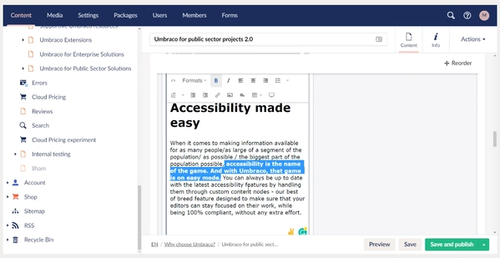
Umbraco is a premier open-source content management system based on the latest .NET (ASP.NET Core) technology, offering flexible building blocks and extensive integration options. Its intuitive user interface simplifies content creation and management, making it ideal for developers and content editors alike. Umbraco supports a wide range of media types including images, videos, and documents, all manageable through its comprehensive Media Library.
The CMS facilitates multi-channel content management, enabling content reuse and multi-language support for diverse digital landscapes. Umbraco's strong API and service layer, combined with its routing pipeline and Models Builder, streamline content rendering and customization. This scalable platform is suited for anything from simple websites to complex digital experiences across various devices and channels.
Umbraco's community-driven approach enhances its development, supported by a global network of developers who contribute to its rich ecosystem of extensions and integrations. This collaborative environment not only fosters innovation but also ensures Umbraco remains a cutting-edge solution for modern digital needs. Its flexibility and ease of use, coupled with robust performance and security features, make Umbraco a top choice for content management.
Bonus: Top Content Management Systems for E-Commerce
Shopify

Shopify is an all-encompassing ecommerce CMS solution designed to help merchants easily build and manage their online stores. As a cloud-based SaaS platform, Shopify eliminates the need for server maintenance and updates, allowing business owners to focus on sales and growth. It is well-suited for a wide range of businesses, from small stores to large enterprises, due to its scalability and ease of use. Key features include a user-friendly online store editor, customizable themes, a robust app store, and seamless integration with various business tools. Additionally, Shopify offers powerful marketing and analytics tools, enabling businesses to reach and retain customers effectively.
One of the standout features of Shopify is its ability to support sales across multiple channels, including online, in-person, and social media platforms. With Shopify's Point of Sale (POS) system, businesses can manage their physical store operations alongside their online store. The platform also supports global sales and B2B transactions, making it a versatile choice for businesses looking to expand their reach. Shopify's comprehensive support includes 24/7 customer service, detailed how-to guides, and business courses, ensuring that users have access to the resources they need to succeed. With competitive pricing plans and a free trial option, Shopify offers a flexible solution for businesses of all sizes.
Adobe Commerce (Formerly Magento)
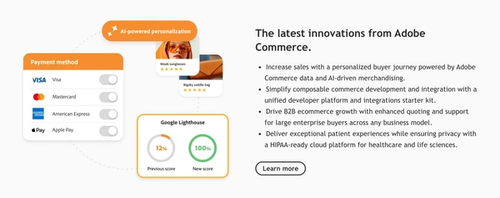
Adobe Commerce, formerly known as Magento, is a powerful e-commerce platform designed to provide comprehensive and personalized shopping experiences. This platform allows businesses to manage and optimize their online stores with advanced features like content customization, inventory management, order processing, and dynamic pricing. Adobe Commerce’s CMS capabilities enable users to create, edit, and publish web content effortlessly, offering a user-friendly interface that does not require extensive technical knowledge. The platform supports various integrations, including CRM, ERP, and marketing automation tools, ensuring a seamless workflow and enhancing overall efficiency.
One of the standout features of Adobe Commerce is its ability to deliver personalized customer experiences through AI-driven product recommendations and customer segmentation. The platform’s robust analytics and BI tools provide deep insights into customer behavior, enabling businesses to tailor their strategies in real-time. Additionally, Adobe Commerce supports the creation of multilingual content and scalable management of large catalogs, making it suitable for global operations. Its flexible and scalable architecture ensures reliable performance, even during high traffic and transaction volumes. With these capabilities, Adobe Commerce remains a leading choice for businesses looking to enhance their digital commerce strategies.
Woocommerce

Woocommerce is a powerful WordPress-based ecommerce platform designed to help merchants and developers build successful online stores. It offers a wide range of extensions and themes to customize and enhance your ecommerce site. With Woocommerce, you can easily set up a fully functional online store, manage products, process payments, and handle shipping without needing extensive technical skills. The platform's flexibility and scalability make it suitable for businesses of all sizes, from small startups to large enterprises.
One of the standout features of Woocommerce is its ability to integrate seamlessly with various third-party tools and services. This allows you to expand your store's functionality through plugins for SEO, marketing, and customer relationship management. Additionally, Woocommerce supports a vast array of payment gateways, making it easy to offer diverse payment options to your customers. With dedicated support and a robust community of developers, Woocommerce provides the resources needed to grow and optimize your online business effectively.
Bigcommerce
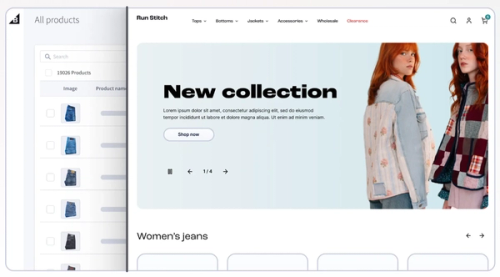
Bigcommerce is a comprehensive eCommerce content management system (CMS) that enables businesses to build, grow, and manage their online stores efficiently. With centralized inventory and order management, it simplifies the sales process across various channels, including eBay, Amazon, Facebook, and Pinterest. The platform's robust integration with leading payment gateways like PayPal, Stripe, and others ensures smooth financial transactions. Additionally, Bigcommerce provides a user-friendly interface for adding, revising, and categorizing products, making it suitable for both complex catalogs and smaller inventories.
The CMS offers advanced SEO tools and an integrated blogging platform to help increase traffic and boost brand awareness. It also supports efficient shipping management with real-time quotes from major carriers and the ability to print shipping labels directly from the control panel. Bigcommerce's Channel Manager and Square integration keep inventory up to date by syncing online and in-person sales, preventing overselling. This platform's extensive features make it an ideal choice for businesses looking to optimize their online presence and streamline operations.
Square Online

Square Online provides a dynamic site editor that allows users to build and customize their e-commerce websites efficiently. With tools for integrating social media, displaying a variety of content types like PDFs and videos, and adding essential features such as contact forms, Square Online caters to a broad range of business needs. The editor is accessible from the Square Online Dashboard and includes a mobile-friendly interface, ensuring that users can manage their sites on the go.
The platform's editing tools are designed to offer real-time updates as users add and modify content. Users can switch between desktop and mobile views, undo and redo changes, and access various page management options to enhance their site's navigation and layout. Additionally, Square Online supports item and category management within its editor, allowing for detailed adjustments in settings like SEO, social media links, and online order prep times.
* This page contains affiliate links to some products and services. If you click on these links and make a purchase, we may earn a commission at no additional cost to you. We only recommend products and services we believe in and that we think will provide value to our audience. For more information, please read our full disclosure policy.
